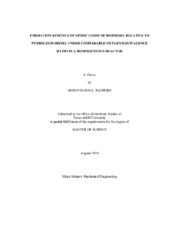| dc.contributor.advisor | Rajagopal, K.R. | |
| dc.contributor.advisor | Jacobs, Timothy J. | |
| dc.creator | Rathore, Gurlovleen K. | |
| dc.date.accessioned | 2011-10-21T22:03:32Z | |
| dc.date.accessioned | 2011-10-22T07:13:51Z | |
| dc.date.available | 2011-10-21T22:03:32Z | |
| dc.date.available | 2011-10-22T07:13:51Z | |
| dc.date.created | 2010-08 | |
| dc.date.issued | 2011-10-21 | |
| dc.date.submitted | August 2010 | |
| dc.identifier.uri | https://hdl.handle.net/1969.1/ETD-TAMU-2010-08-8515 | |
| dc.description.abstract | Interest in biodiesel has piqued with advent of stringent emissions regulations. Biodiesel is a viable substitute for petroleum diesel because biodiesel produces significantly lower particulate and soot emissions relative to petroleum diesel. Higher nitric oxide (NO) emissions for biodiesel, however, are of primary concern in biodiesel-fueled engines. Search for an in-cylinder technique to reduce NO emissions for biodiesel has motivated studies to gain an improved understanding of fundamental factors that drive increase in NO emissions with biodiesel. Potential factors include fuel-bound oxygen, fuel-bound nitrogen and post-flame gas temperature. The role of fuel-bound oxygen however is debated in the literature. The research objective of this study is to computationally determine if biodiesel and petroleum diesel yield equivalent concentrations of NO with the same oxygen equivalence ratio in a 0-D homogeneous reactor, to explain the role of fuel-bound oxygen in biodiesel on increases in NO emissions with biodiesel.
The results from this study indicate that the biodiesel surrogate yields higher NO emissions than the n-heptane because of its lower oxygen consumption efficiency. The lower oxygen consumption efficiency for biodiesel is likely because of the slower decomposition of the individual components and the blending ratios of the biodiesel surrogate blend. The relative differences in combustion efficiency of individual components of the biodiesel blend suggest this conclusion. The more efficient burning of the methyl esters relative to the n-heptane in biodiesel surrogate perhaps indicates the favorable role of fuel-bound oxygen in the fuel’s combustion. The low utilization of oxygen by the biodiesel surrogate could not be explained in this study. The dominance of NO2 H ↔ NO OH and N NO ↔ N2 O mechanisms during biodiesel combustion however explain the high NO emissions for the biodiesel surrogate relative to the n-heptane. The biodiesel may yield lower NO emissions than the petroleum diesel if the blending ratios for the biodiesel are adjusted such that combustion efficiency of biodiesel and petroleum diesel is same or the NO2 H ↔ NO OH and N NO ↔ N2 O mechanisms are suppressed during biodiesel combustion. | en |
| dc.format.mimetype | application/pdf | |
| dc.language.iso | en_US | |
| dc.subject | Nitric Oxide | en |
| dc.subject | Biodiesel | en |
| dc.subject | Petroleum Diesel | en |
| dc.subject | Formation Kinetics | en |
| dc.subject | Oxygen Equivalence Ratio | en |
| dc.title | Formation Kinetics of Nitric Oxide of Biodiesel Relative to Petroleum Diesel under Comparable Oxygen Equivalence Ratio in a Homogeneous Reactor | en |
| dc.type | Thesis | en |
| thesis.degree.department | Mechanical Engineering | en |
| thesis.degree.discipline | Mechanical Engineering | en |
| thesis.degree.grantor | Texas A&M University | en |
| thesis.degree.name | Master of Science | en |
| thesis.degree.level | Masters | en |
| dc.contributor.committeeMember | Caton, Jerald A. | |
| dc.contributor.committeeMember | Walton, Jay and Fowler, Debra | |
| dc.type.genre | thesis | en |
| dc.type.material | text | en |


